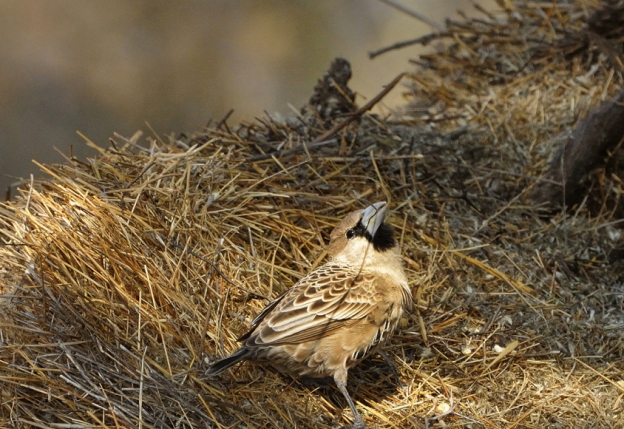
The world’s most populated tree houses, the huge communal nests of Africa’s Weaverbirds serve many benefits for it’s multi-generational occupants.
The nests of most songbirds are small and hidden, made by one bird or a pair, and function only to hold, hide, and protect one clutch of eggs and young. The nests of the sociable weavers, African birds of the Namib and Kalahari deserts of southern Africa, do much more. They are the world’s largest and most populated tree houses, weighing up to a ton or more and ranging up to 20 feet wide and 10 feet tall.

[This story, about Africa’s Weaverbirds was originally published in the March-April 2014 issue of Audubon Magazine and is an excerpt from The Homing Instinct, written by Bernd Heinrich.]
One of these communal homes contains a hundred or more nesting chambers, or apartments. They’re refurbished and reused, with residents adding new ones over successive generations, often for more than a century. Each generation inherits, builds on, and profits from the environment created by its predecessors.
Unlike most weaverbirds, sociable weaverbirds don’t “weave.” Their nests look like huts, complete with a sloping thatched-grass roof that sheds rain. The structure grows as the birds add new apartments, inserting dry grasses into the bottoms and sides. Each of the hundred or more breeding pairs tends to its own compartment.
The couples line the interior with soft downy plant material and construct a private entrance–a 10-inch-long, one-inch-wide passageway–out of downward-pointing spiky straws that keeps out snakes. With dozens and dozens of entrances packed closely together, the underside of the communal home has a honeycomb appearance.
The weavers’ nest-building drive, and their attachment to their dwellings, is so strong that they not only live in and around their nest all year, but they are also constantly making home improvements.
Apartment Complex for African Birds
Like a human apartment building–to which it is impossible not to draw comparisons–the sociable weaver’s home shelters all of its residents from the elements. It blocks direct sunshine and also protects them from rain, drought, and cold. Such protection is critical in the bird’s native Kalahari: temperatures can climb to 110 degrees Fahrenheit in the summer and dip to 14 degrees Fahrenheit in the winter.
In many animals, scorching summer temperatures demand water for evaporative cooling, and most birds regularly need water to shed excess body heat by gular fluttering, a process similar to panting in which increased air movement in the moist throat area accelerates evaporative water loss. But by retreating into the communal nest at high temperatures, the sociable weavers save water otherwise needed to dissipate heat–enough so they can get by without drinking for days at a time. Not needing to be near water may have allowed the birds to expand their ranges into otherwise inhospitable environs.
When the mercury drops in winter, the birds spend nights in the nest, saving the energy otherwise needed for shivering to keep warm, thereby saving food. Some apartments used by pairs rearing their young during the breeding season are converted into housing for up to five adults during the cold season. When frost blankets the desert, they huddle together indoors, where the temperature stays about 60 degrees Fahrenheit above that outside.
With the communal nest serving as a year-round dormitory and refuge, it’s understandable that the young of these already sociable birds are reluctant to leave their home after they fledge. Instead, they stay, earning their keep by helping their parents feed subsequent broods.

Weaverbird Architects
The similarities between the sociable weaver’s communal nests and human apartment buildings may be more than happenstance. Avian structures might have inspired our first abodes. Given our imagination, early humans would have been aware of what other animals did. Perhaps our homes at first converged to resemble (and possibly mimic?) those of the resident birds.
The Pygmies of the Ituri Forest in central Africa build round huts next to each other. Woven from branches and covered with leaves, these huts are reminiscent of weaverbird nests. The Maasai of Kenya and Tanzania construct huts arranged in a small colony, as swallows often do, with added precautions: Their semi-permanent home is surrounded by a wall of thornbushes as a defense against lions. The Anasazi of the American Southwest built cliff dwellings with clay and straw, materials much like those used by swallows, phoebes, and some other birds.
The structures that our human ancestors lived in 150,000 years ago might have resembled these structures, but we can’t know for certain. They were almost certainly perishable and would not have fossilized. All traces of similar homes of predecessors in Europe, Africa, Asia, America, or Australia would have vanished, much as any bird nests of grass, leaves, and sticks would have done.
AUTHOR PROFILE:
Bernd Heinrich is an acclaimed scientist and the author of numerous award-winning books, including the best-selling Mind of the Raven and his newest book The Homing Instinct, from which this article is an excerpt.
Join other Africa, wildlife, and bird lovers at SavingWild.com:
2 Replies to “Weaverbirds Nests are Like Huts”
Comments are closed.

The social weaver nests are absolutely fascinating to me. Would love to see a cross-section of the inside of one! Thanks for the interesting info. 🙂
What a great idea Shara. I would love that too as long as we could do it without disrupting their complex. We need to look at one that is blown down. Next time I am in Africa if I find one I will definitely look inside and report back.:) thanks for commenting.